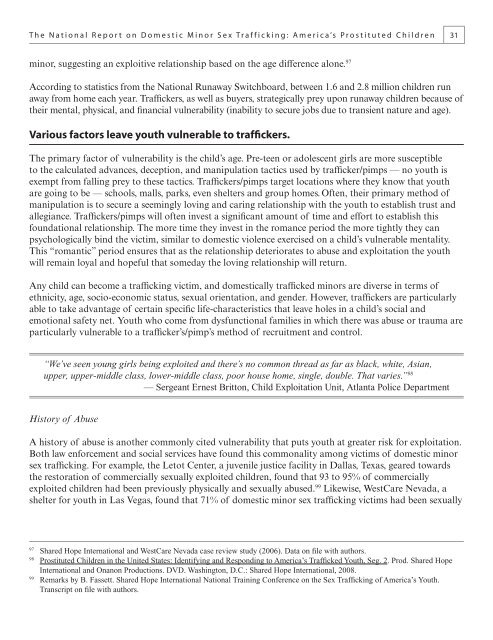By Linda A Smith Samantha Healy Vardaman Melissa A Snow
The National Report on Domestic Minor Sex Trafficking
The National Report on Domestic Minor Sex Trafficking
Create successful ePaper yourself
Turn your PDF publications into a flip-book with our unique Google optimized e-Paper software.
The National Report on Domestic Minor Sex Trafficking: America’s Prostituted Children 31minor, suggesting an exploitive relationship based on the age difference alone. 97According to statistics from the National Runaway Switchboard, between 1.6 and 2.8 million children runaway from home each year. Traffickers, as well as buyers, strategically prey upon runaway children because oftheir mental, physical, and financial vulnerability (inability to secure jobs due to transient nature and age).Various factors leave youth vulnerable to traffickers.The primary factor of vulnerability is the child’s age. Pre-teen or adolescent girls are more susceptibleto the calculated advances, deception, and manipulation tactics used by trafficker/pimps — no youth isexempt from falling prey to these tactics. Traffickers/pimps target locations where they know that youthare going to be — schools, malls, parks, even shelters and group homes. Often, their primary method ofmanipulation is to secure a seemingly loving and caring relationship with the youth to establish trust andallegiance. Traffickers/pimps will often invest a significant amount of time and effort to establish thisfoundational relationship. The more time they invest in the romance period the more tightly they canpsychologically bind the victim, similar to domestic violence exercised on a child’s vulnerable mentality.This “romantic” period ensures that as the relationship deteriorates to abuse and exploitation the youthwill remain loyal and hopeful that someday the loving relationship will return.Any child can become a trafficking victim, and domestically trafficked minors are diverse in terms ofethnicity, age, socio-economic status, sexual orientation, and gender. However, traffickers are particularlyable to take advantage of certain specific life-characteristics that leave holes in a child’s social andemotional safety net. Youth who come from dysfunctional families in which there was abuse or trauma areparticularly vulnerable to a trafficker’s/pimp’s method of recruitment and control.“We’ve seen young girls being exploited and there’s no common thread as far as black, white, Asian,upper, upper-middle class, lower-middle class, poor house home, single, double. That varies.” 98— Sergeant Ernest Britton, Child Exploitation Unit, Atlanta Police DepartmentHistory of AbuseA history of abuse is another commonly cited vulnerability that puts youth at greater risk for exploitation.Both law enforcement and social services have found this commonality among victims of domestic minorsex trafficking. For example, the Letot Center, a juvenile justice facility in Dallas, Texas, geared towardsthe restoration of commercially sexually exploited children, found that 93 to 95% of commerciallyexploited children had been previously physically and sexually abused. 99 Likewise, WestCare Nevada, ashelter for youth in Las Vegas, found that 71% of domestic minor sex trafficking victims had been sexually97Shared Hope International and WestCare Nevada case review study (2006). Data on file with authors.98Prostituted Children in the United States: Identifying and Responding to America’s Trafficked Youth, Seg. 2. Prod. Shared HopeInternational and Onanon Productions. DVD. Washington, D.C.: Shared Hope International, 2008.99Remarks by B. Fassett. Shared Hope International National Training Conference on the Sex Trafficking of America’s Youth.Transcript on file with authors.
















